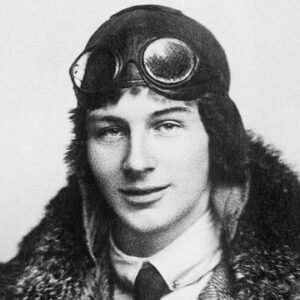Anthony Fokker was a Dutch innovator and manufacturer who made significant contributions to the aviation industry in the early 1900s. Fokker, who had an early interest in aviation mechanics, began developing and producing extraordinary airplanes in his twenties. After only two years of creating his first prototype, he entered the aviation sector as an entrepreneur. After a daring display on a German Army base, he initiated business relations with the German military. Soon after the outbreak of World War I, the Imperial military had a great need for Fokker’s aircraft. He designed many cutting-edge technologies that provided German fighter pilots an advantage over their adversaries’ rudimentary planes. Upon the conclusion of the war, he entered the commercial industry, which was just beginning to flourish in the United States. Before selling his company to General Motors, he contributed significantly to the commercial aviation industry. As well as being one of the most talented pilots of his day, he was also a genius in aeronautics.
Youth and Early Life
Anthony Fokker was born in Kediri, Dutch East Indies, on April 6, 1890. (now known as Indonesia).
At the time of his birth, his father, Herman Fokker, was a Dutch coffee plantation owner in the Dutch East Indies. Herman relocated his two children to the Netherlands and settled in Haarlem in an effort to provide them with a Dutch upbringing.
In his youth, Fokker was disinterested in school. This caused him to drop out of high school prior to graduating.
Early on, he showed an interest in mechanicals. He loved creating objects and experimenting with various aircraft designs.
In 1908, after hearing about Wilbur Wright’s flight shows in France, he became interested in airplanes. He began to concentrate on aircraft design.
Anthony Fokker’s Career
In 1910, his father sent him to the Bingen Technical School in Germany to become an auto mechanic. However, he switched to ‘Erste-Deutsche Automobile-Faschschule’ in Mainz due to his interest in airplane mechanics.
Fokker developed and constructed his first open monoplane, Die Spinne (The Spider), in 1910. The plane was wrecked shortly after its construction when his business partner crashed it into a tree.
The sad destruction of his ‘Die Spinner aircraft led to the construction of a second prototype named simply ‘Spin’ This aircraft was utilized to obtain his pilot’s license.
On August 31, 1911, he rose to prominence when he piloted the third version of his ‘Spin’ aircraft around the Sint-Bavokerk tower in Haarlem. The fact that the date coincided with Queen Wilhelmina’s birthday increased the public’s interest.
With his father’s funding, he relocated to Johannisthal, close to Berlin, and established his first business, Fokker Aeroplanbau.
Johannisthal was a hotspot for aircraft manufacturers and aficionados. To gain the upper hand, he transported the components of one of his Scout plane models to a German military facility nearby. Once outside, he quickly built the aircraft and was airborne within minutes. This impressed German army leaders, who immediately ordered two aircraft.
In 1914, at the beginning of World War I, the German government acquired control of the newly created firm. They retained Fokker as the Luftstreitkräfte’s (Imperial German Air Service) director and designer.
During the war, Fokker supplied the German government with nearly 700 military aircraft. These aircraft included the “Fokker Eindecker” and the “Fokker Dr. I,” which was piloted by Manfred von Richthofen (the “Red Baron”).
In 1915, Fokker created a Scout aircraft with a device that synchronized the discharge of the machine cannon with the propeller’s spin. This device guaranteed that bullets never interfered with the propeller’s operation. After the legendary German fighter pilot Max Immelmann completed a successful mission, the Germans ordered large numbers of aircraft to be deployed in battle.
In accordance with the Treaty of Versailles, Fokker’s factories were ordered liquidated following the German capitulation at the end of the First World War. To avoid losing everything, he snuck into Holland hundreds of his designs. He relaunched his factory in Veere, renaming it the Dutch Aircraft Factory (Dutch Aircraft Factory).
In 1927, when his tri-motor aircrafts dominated the early commercial flight market, he moved to the United States. He established “Atlantic Aircraft Company.”
In 1931, when Fokker sold his aircraft plants to ‘General Motors,’ the ‘Atlantic Aircraft Company’ became the ‘General Aviation Corporation’
His Major Opera
In 1916, Fokker introduced a fighter biplane with synchronized machine guns. This was a response to the French acquiring his earlier Scout model, which included a single machine gun and mechanism.
During the First World War, the D-7 became one of the most agile fighter aircraft available. It was overwhelmingly picked for rapid manufacture and deployment by German officials.
Fokker’s factory in the United States developed an aircraft named ‘Josephine Ford’ after Henry Ford’s granddaughter. On May 9, 1926, Lieutenant Commander Richard Byrd and Floyd Bennett flew this aircraft over the North Pole.
Personal History and Legacy
On March 25, 1919, Fokker married Sophie Marie Elisabeth Von Morgen. Their marriage terminated barely four years later in divorce.
He married again in 1927. His second wife was Violet Eastman, a Canadian. Two years later, after his wife fell from their hotel suite window, he became a widower. According to Fokker’s request, the police report was revised to read vertigo victim rather than suicide.
Fokker died of pneumococcal meningitis in New York City on December 23, 1939, at the age of 49.
Estimated Net Worth
Anthony is one of the wealthiest and most well-known pilots. According to our research, Wikipedia, Forbes, and Business Insider, Anthony Fokker has an estimated net worth of $1.5 million.


